 Our investigation was situated in the natural geochemical arsenic anomaly at Smolotely-Líšnice Au district (Central Bohemia). Using the combination of geochemical (bulk soil and pore water analyses, selective chemical extractions, S isotopes), mineralogical (XRD, TEM, SEM/EDS) and biological (DNA extraction) methods we characterized massive accumulations of authigenic arsenic and iron sulfides (realgar, bonazziite, pyrite and greigite) on the fragments of organic matter that were buried in the shallow wetland soil. We have shown that by the development of suitable conditions of sulfidogenesis (very fast microbial sulfate reduction vs. slow transfer of solutes), fragments of organic matter may play an active role in arsenic immobilization in wetland systems.
Our investigation was situated in the natural geochemical arsenic anomaly at Smolotely-Líšnice Au district (Central Bohemia). Using the combination of geochemical (bulk soil and pore water analyses, selective chemical extractions, S isotopes), mineralogical (XRD, TEM, SEM/EDS) and biological (DNA extraction) methods we characterized massive accumulations of authigenic arsenic and iron sulfides (realgar, bonazziite, pyrite and greigite) on the fragments of organic matter that were buried in the shallow wetland soil. We have shown that by the development of suitable conditions of sulfidogenesis (very fast microbial sulfate reduction vs. slow transfer of solutes), fragments of organic matter may play an active role in arsenic immobilization in wetland systems.
Knappová M., Drahota P., Falteisek L., Culka A., Penížek V., Trubač J., Mihaljevič M., Matoušek T. (2019): Microbial sulfidogenesis of arsenic in naturally contaminated wetland soil. Geochimica et Cosmochimica Acta 267, 33-50. (DOI)









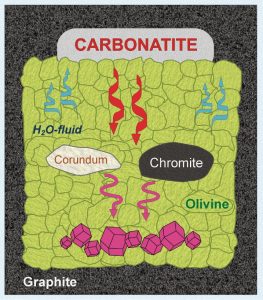 Newly performed experiments focused on formation of subcalcic Cr-rich garnet in the model ultramafic system corresponding to natural harzburgite with the presence of REE-bearing fluid phase. The experiments were carried out using a multi-anvil high-pressure apparatus at a pressure of 5 GPa and a temperature of 1300 °C. Natural serpentine, chromite, corundum and REE-carbonatite were used as starting components. Crystallization of garnet occurred in subsolidus conditions by the reaction of orthopyroxene and spinel in the presence of fluid phase. Composition of fluid was controlled by interaction of water released by decomposition of serpentine with carbonate. By using different amounts of carbonatite as a source of calcium and REE, subcalcic Cr-rich garnets were crystallized, which are typical for inclusions of harzburgitic paragenesis in natural diamonds. The experiments demonstrated that the REEs released from the initial carbonatite were transported by the fluid and were incorporated into the newly formed garnet. These results confirmed high partitioning of HREE into garnet. The present study indicates that the mantle carbonatites, which contain very high proportions of REE, can play an important role as source material in formation of REE-rich fluids to crystallize garnets with typical REE patterns in mantle peridotites.
Newly performed experiments focused on formation of subcalcic Cr-rich garnet in the model ultramafic system corresponding to natural harzburgite with the presence of REE-bearing fluid phase. The experiments were carried out using a multi-anvil high-pressure apparatus at a pressure of 5 GPa and a temperature of 1300 °C. Natural serpentine, chromite, corundum and REE-carbonatite were used as starting components. Crystallization of garnet occurred in subsolidus conditions by the reaction of orthopyroxene and spinel in the presence of fluid phase. Composition of fluid was controlled by interaction of water released by decomposition of serpentine with carbonate. By using different amounts of carbonatite as a source of calcium and REE, subcalcic Cr-rich garnets were crystallized, which are typical for inclusions of harzburgitic paragenesis in natural diamonds. The experiments demonstrated that the REEs released from the initial carbonatite were transported by the fluid and were incorporated into the newly formed garnet. These results confirmed high partitioning of HREE into garnet. The present study indicates that the mantle carbonatites, which contain very high proportions of REE, can play an important role as source material in formation of REE-rich fluids to crystallize garnets with typical REE patterns in mantle peridotites.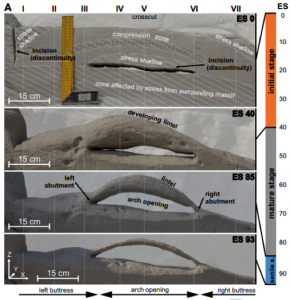 People tend to admire well-developed rock arches and bridges as a symbol of perfection in nature. However, the origin of such arches still remains unclear, with different authors emphasizing different factors as essential. An authentic small-scale physical model of a perfect arch was created in situ from friable sandstone through a simulation of natural erosion. Based on three-dimensional photogrammetric and numerical modeling, we established three evolutionary stages of the modeled arch: the initial, mature, and senile stages. Erosion removed the material from stress shadows, thus exposing the compressed zone of the material, which spans over the discontinuity. From its original lintel thickness with a length ratio of 0.3, the modeled arch thinned out to a ratio of 0.03, which is close to the best-developed natural arches. The erosion rate of the arch surface was relatively low for 90% of its lifespan, but the last 10% was characterized by an abrupt increase in the erosion rate. Our results show that the only conditions essential to producing a delicate arch through erosion are a thin, vertically elongated rock body with an appropriate discontinuity, and a material prone to stress-controlled erosion.
People tend to admire well-developed rock arches and bridges as a symbol of perfection in nature. However, the origin of such arches still remains unclear, with different authors emphasizing different factors as essential. An authentic small-scale physical model of a perfect arch was created in situ from friable sandstone through a simulation of natural erosion. Based on three-dimensional photogrammetric and numerical modeling, we established three evolutionary stages of the modeled arch: the initial, mature, and senile stages. Erosion removed the material from stress shadows, thus exposing the compressed zone of the material, which spans over the discontinuity. From its original lintel thickness with a length ratio of 0.3, the modeled arch thinned out to a ratio of 0.03, which is close to the best-developed natural arches. The erosion rate of the arch surface was relatively low for 90% of its lifespan, but the last 10% was characterized by an abrupt increase in the erosion rate. Our results show that the only conditions essential to producing a delicate arch through erosion are a thin, vertically elongated rock body with an appropriate discontinuity, and a material prone to stress-controlled erosion.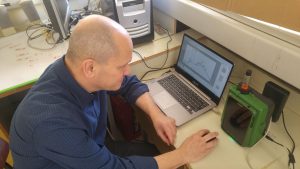 Discrimination of carotenoids in samples of carotene-producing microorganisms was carried-out using four miniature portable Raman spectrometers in a detailed comparison study. Two spectrometers using a green laser allowing to obtain Resonance Raman (or pre-Resonance Raman) signals, one instrument with a 785 nm laser, and a recently developed Portable Sequentially Shifted Excitation Raman spectrometer (PSSERS) were used for identifying major pigments of different halophilic (genera Halobacterium, Halorubrum, Haloarcula, Salinibacter, Ectothiorhodospira, Dunaliella) and non-halophilic microorganisms (Micrococcus luteus, Corynebacterium glutamicum). Using all the tested instruments including the PSSERS, strong carotenoids signals corresponding to the stretching vibrations in the polyene chain and in-plane rocking modes of the attached CH3 groups were found at the correct positions. Raman spectra of carotenoids can be obtained from different types of microbiological samples (wet pellets, lyophilized culture biomass and pigment extracts in organic solvents), and can be collected fast and without time-consuming procedures.
Discrimination of carotenoids in samples of carotene-producing microorganisms was carried-out using four miniature portable Raman spectrometers in a detailed comparison study. Two spectrometers using a green laser allowing to obtain Resonance Raman (or pre-Resonance Raman) signals, one instrument with a 785 nm laser, and a recently developed Portable Sequentially Shifted Excitation Raman spectrometer (PSSERS) were used for identifying major pigments of different halophilic (genera Halobacterium, Halorubrum, Haloarcula, Salinibacter, Ectothiorhodospira, Dunaliella) and non-halophilic microorganisms (Micrococcus luteus, Corynebacterium glutamicum). Using all the tested instruments including the PSSERS, strong carotenoids signals corresponding to the stretching vibrations in the polyene chain and in-plane rocking modes of the attached CH3 groups were found at the correct positions. Raman spectra of carotenoids can be obtained from different types of microbiological samples (wet pellets, lyophilized culture biomass and pigment extracts in organic solvents), and can be collected fast and without time-consuming procedures. This study focuses on the investigation of three uncommon complex iron sulfates – clairite, metavoltine, and voltaite – using Raman spectroscopy. The investigated specimens were formed at the burning coal dump Anna I (Alsdorf, Germany) due to alteration processes connected with the subsurface thermal activity. The results demonstrate proliferation of Raman bands and extraordinary strong spectral features connected with the specific crystal structures of these minerals. These data obtained here can serve as the reference material for the investigation of sulfate encrustation of fumarolic sulfide-weathering origin as well as can be implemented into the mineral databases important for the geological and mineralogical exploration of other extraterrestrial bodies.
This study focuses on the investigation of three uncommon complex iron sulfates – clairite, metavoltine, and voltaite – using Raman spectroscopy. The investigated specimens were formed at the burning coal dump Anna I (Alsdorf, Germany) due to alteration processes connected with the subsurface thermal activity. The results demonstrate proliferation of Raman bands and extraordinary strong spectral features connected with the specific crystal structures of these minerals. These data obtained here can serve as the reference material for the investigation of sulfate encrustation of fumarolic sulfide-weathering origin as well as can be implemented into the mineral databases important for the geological and mineralogical exploration of other extraterrestrial bodies.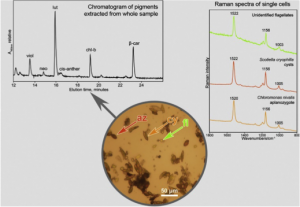 The potential of Raman microspectroscopy for the determination of carotenoid pigments (both primary: lutein, beta-carotene, and secondary: astaxanthin carotenoids) in the different species and life-cycle stages of snow algae from the order Chlamydomonadales (Chlorophyta) was tested alongside a comparison of a reference method of biological pigment analysis: high-performance liquid chromatography. The three main carotenoid Raman bands of the astaxanthin-rich red cysts were located at 1520, 1156 and 1006 cm−1. The shifts (orange aplanozygotes and green motile cells with flagella) in the position of the ν1(C=C) Raman band of the polyenic chain is consistent with the expected changes in the ratios of the various carotenoid pigments. Flagellated green cells commonly contain lutein as a major carotenoid, together with minor amounts of β carotene and varying amounts of antheraxanthin, violaxanthin and neoxanthin. Aplanozygotes contain mixtures of both primary and secondary carotenoids. In most cases, the ν1(C=C) band is an overlapping set of bands, which is due to the signal of all carotenoid pigments in the sample, and a deconvolution along with the band position shifts (mainly ν1) could be used to characterize the mixture of carotenoids.
The potential of Raman microspectroscopy for the determination of carotenoid pigments (both primary: lutein, beta-carotene, and secondary: astaxanthin carotenoids) in the different species and life-cycle stages of snow algae from the order Chlamydomonadales (Chlorophyta) was tested alongside a comparison of a reference method of biological pigment analysis: high-performance liquid chromatography. The three main carotenoid Raman bands of the astaxanthin-rich red cysts were located at 1520, 1156 and 1006 cm−1. The shifts (orange aplanozygotes and green motile cells with flagella) in the position of the ν1(C=C) Raman band of the polyenic chain is consistent with the expected changes in the ratios of the various carotenoid pigments. Flagellated green cells commonly contain lutein as a major carotenoid, together with minor amounts of β carotene and varying amounts of antheraxanthin, violaxanthin and neoxanthin. Aplanozygotes contain mixtures of both primary and secondary carotenoids. In most cases, the ν1(C=C) band is an overlapping set of bands, which is due to the signal of all carotenoid pigments in the sample, and a deconvolution along with the band position shifts (mainly ν1) could be used to characterize the mixture of carotenoids. We used a multi-method approach for characterization of dust from mines and smelters in the northern Namibia. In vitro bioaccessibility testing in simulated gastric fluid (SGF) indicated that As, Pb (and also Cd to a lesser extent) exceeded tolerable daily intake limits for these contaminants in the case of slags and smelter dusts, but the exposure risk for local population is only important at the unfenced disposal sites.
We used a multi-method approach for characterization of dust from mines and smelters in the northern Namibia. In vitro bioaccessibility testing in simulated gastric fluid (SGF) indicated that As, Pb (and also Cd to a lesser extent) exceeded tolerable daily intake limits for these contaminants in the case of slags and smelter dusts, but the exposure risk for local population is only important at the unfenced disposal sites. New discoveries in trilobite research: a large sample of developmental stages of trilobite genus Dalmanitina from the Ordovician of the Prague Basin allowed Lukáš Laibl and his colleagues to describe ontogeny of basal members of the suborder Phacopina. Adult phacopines are recognised by their fused facial sutures, which in other trilobites are non-fused and used during the moulting process. This means that rather than molting through the sutural gape mode, characterized by opening of the facial sutures and separation of the librigenae, adult phacopines disarticulated the entire cephalon in so called Salter’s mode of molting. Early developmental stages of Phacopina, however, moulted by sutural gape mode because they retained unfused facial sutures. The fusion of facial sutures occured during the postembryonic development and its developmental timing was intraspecifically fixed in most of the members of the group. However, this was not the case for Dalmanitina as in this genus facial suture fusion occurred variably in ontogeny. This confirms the hypothesis that basal members of major clades have less contrained developmental programs. The material also provides insight into how linked morphologies and behaviors evolved, potentially suggesting the timing of facial suture fusion in Phacopina moved earlier during development and became more intraspecifically fixed over geological time.
New discoveries in trilobite research: a large sample of developmental stages of trilobite genus Dalmanitina from the Ordovician of the Prague Basin allowed Lukáš Laibl and his colleagues to describe ontogeny of basal members of the suborder Phacopina. Adult phacopines are recognised by their fused facial sutures, which in other trilobites are non-fused and used during the moulting process. This means that rather than molting through the sutural gape mode, characterized by opening of the facial sutures and separation of the librigenae, adult phacopines disarticulated the entire cephalon in so called Salter’s mode of molting. Early developmental stages of Phacopina, however, moulted by sutural gape mode because they retained unfused facial sutures. The fusion of facial sutures occured during the postembryonic development and its developmental timing was intraspecifically fixed in most of the members of the group. However, this was not the case for Dalmanitina as in this genus facial suture fusion occurred variably in ontogeny. This confirms the hypothesis that basal members of major clades have less contrained developmental programs. The material also provides insight into how linked morphologies and behaviors evolved, potentially suggesting the timing of facial suture fusion in Phacopina moved earlier during development and became more intraspecifically fixed over geological time.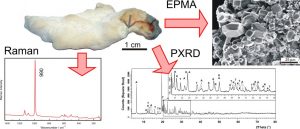 Khademite and rostite are rare orthorhombic minerals Al(SO4)F·5H2O and Al(SO4)OH·5H2O, respectively. Libušín is a type locality of rostite but recent studies have only confirmed the presence of khademite. New electron microprobe analyses of khademite from Libušín revealed a fluorine concentration of 8.12–8.18 wt.%, which is the highest ever found for khademite. Precise discrimination of structurally very similar sulfates is of high importance for geochemical studies and a combination of different analytical methods is preferred to reach this goal.
Khademite and rostite are rare orthorhombic minerals Al(SO4)F·5H2O and Al(SO4)OH·5H2O, respectively. Libušín is a type locality of rostite but recent studies have only confirmed the presence of khademite. New electron microprobe analyses of khademite from Libušín revealed a fluorine concentration of 8.12–8.18 wt.%, which is the highest ever found for khademite. Precise discrimination of structurally very similar sulfates is of high importance for geochemical studies and a combination of different analytical methods is preferred to reach this goal. New U-Pb detrital zircon ages obtained in collaboration with Goethe University (Frankfurt am Main, Germany) and Czech Academy of Sciences from siliciclastic rocks of the Central Bohemian Massif document an intriguing example of how protracted and complex may be a transformation of an active plate margin, controlled by subduction of an oceanic plate, to a passive continental shelf. The northern rim of the supercontinent Gondwana underwent this transition during the late Neoproterozoic to Cambrian times. In their plate-tectonic reconstruction, Hajná et al. assigned a key role to obliquity of the oceanic subduction and impingement of a hot oceanic ridge into the deep sea trench, emhasizing the analogy with modern geotectonic settings.
New U-Pb detrital zircon ages obtained in collaboration with Goethe University (Frankfurt am Main, Germany) and Czech Academy of Sciences from siliciclastic rocks of the Central Bohemian Massif document an intriguing example of how protracted and complex may be a transformation of an active plate margin, controlled by subduction of an oceanic plate, to a passive continental shelf. The northern rim of the supercontinent Gondwana underwent this transition during the late Neoproterozoic to Cambrian times. In their plate-tectonic reconstruction, Hajná et al. assigned a key role to obliquity of the oceanic subduction and impingement of a hot oceanic ridge into the deep sea trench, emhasizing the analogy with modern geotectonic settings.